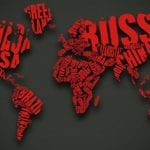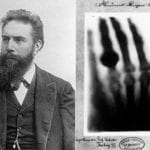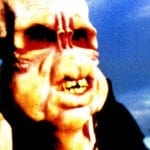 Misconceptions
Misconceptions  Misconceptions
Misconceptions  History
History 10 Amazing Roman Epitaphs
 Weird Stuff
Weird Stuff 10 Niche Subcultures That Are More Popular Than You Might Think
 Mysteries
Mysteries 10 Tragic Disappearances and Deaths in Joshua Tree National Park
 History
History 10 Ways Childhood Really Sucked in the Old West
 Music
Music 10 Name Origins of Famous Bands from the 1990s
 Religion
Religion 10 Biggest Turnarounds by the Catholic Church
 Weird Stuff
Weird Stuff 10 Unbelievable Times Laws Had Unintended Consequences
 Humans
Humans Ten Historic Women Who Deserve Way More Credit Than They Got
 Movies and TV
Movies and TV 10 Films That Spawned Major Lawsuits
 Misconceptions
Misconceptions 10 Phony Myths and Urban Legends That Just Won’t Die
 History
History 10 Amazing Roman Epitaphs
 Weird Stuff
Weird Stuff 10 Niche Subcultures That Are More Popular Than You Might Think
Who's Behind Listverse?

Jamie Frater
Head Editor
Jamie founded Listverse due to an insatiable desire to share fascinating, obscure, and bizarre facts. He has been a guest speaker on numerous national radio and television stations and is a five time published author.
More About Us Mysteries
Mysteries 10 Tragic Disappearances and Deaths in Joshua Tree National Park
 History
History 10 Ways Childhood Really Sucked in the Old West
 Music
Music 10 Name Origins of Famous Bands from the 1990s
 Religion
Religion 10 Biggest Turnarounds by the Catholic Church
 Weird Stuff
Weird Stuff 10 Unbelievable Times Laws Had Unintended Consequences
 Humans
Humans Ten Historic Women Who Deserve Way More Credit Than They Got
 Movies and TV
Movies and TV 10 Films That Spawned Major Lawsuits
Top 10 Facts That Change How You See The Story Of The Mayflower
The Pilgrims who boarded the Mayflower and sailed across the ocean to America, we’re told, were trying to set up a new colony free of religious persecution—but there was a bit more to the story than that. The Pilgrims weren’t just a group of religious Puritans. The real story of the colony that one day grew into the most powerful nation in the world isn’t exactly pure.
10The Pilgrims Were Actually Escaping The Religious Tolerance Of The Dutch

The Pilgrims didn’t flee religious persecution in England by going to America—they went to the Netherlands.
Long before the Pilgrims stepped aboard the Mayflower, they settled in a Dutch city called Leiden, where they were welcomed with open arms. The Dutch let them hold Puritan services in their churches, promising that they let all honest people live freely in their nation.
And they did. The Dutch lived up to their promise—but the Puritans realized maybe religious freedom wasn’t what they wanted after all. They complained about the “extravagant and dangerous” lifestyle of the Dutch, who, they complained, were depraved enough to spend part of the Sabbath not resting. The Puritans were worried that their children might be swept away by the depraved and wild lifestyle of doing work on the Sabbath. The young Puritans, William Bradford wrote, were being “drawn away by evil examples” by “the great licentiousness of youth in that country.”[1]
And so they boarded the Mayflower—not to escape religious persecution, which they’d already escaped by going to the Netherlands, but to escape the religious tolerance of the Dutch.
9French Pilgrims Went To America First

The Pilgrims on the Mayflower weren’t the first people to have the idea—some French settlers had already gone off to America in search of religious freedom 55 years before them. They didn’t find it. Instead, they found the Spanish, and what happened next makes it a bit easier to understand why the Puritans didn’t want to stay in Europe.
The French set up a settlement called Fort Caroline and began living lives as Lutheran Protestants, away from all the religious wars of Europe—until Europe found them. A Spanish army led by Pedro Menendez de Aviles tracked them down and killed them all, for no other reason, as he proudly explained, than “for being Lutherans.”[2]
The Spanish climbed over the French walls with ladders, snuck into their bedrooms, and attacked. The French Pilgrim’s piousness was no match for the Spanish conquistador’s guns and their willingness to sneak into someone’s bedroom and murder him in his sleep.
132 Pilgrims died—nearly every single person there. And the Spanish conquistadors renamed the fort “Mantazas,” meaning “massacre,” to commemorate their favorite pastime.
8A Man Put His Kids On The Mayflower To Spite His Wife

The strangest names on the passenger list of the Mayflower were the More children: four unaccompanied minors, all under nine years old, sailing off to America without their parents.
The Mores were the children of Samuel and Katherine More—or, at least, that’s what Katherine told Samuel. As the kids grew older, though, Samuel started noticing that they didn’t look very much like him. Instead, looked an awful lot like Jacob Blakeway, the guy his wife kept insisting was just a friend.
Samuel More divorced his wife, but under English law, he still had legal authority over his kids. He also absolutely hated his wife, so, purely out of spite, he handed her kids off to the Puritans and bought them a one-way ticket on the Mayflower.
All but one of the kids died during the first winter. The sole survivor was Richard More, who ended up settling in Salem. Apparently, he still had his biological father’s genes—years later, he was convicted for “gross unchastity with another man’s wife.”[3]
7Less Than Half Of The People On The Mayflower Were Puritans

Despite how we imagine it, the Mayflower wasn’t a boat full of Puritans. In fact, out of the 102 people on the boat, more than 60 were Anglicans—followers of the very religion the Puritans were trying to escape.
The Puritans let the Anglicans come with them because they needed their money. Sailing two boats to the New World and setting up a colony was expensive, and they needed investors. They made it clear, though, they weren’t part of the group. They called these Anglicans “Strangers” and called themselves “Saints.” Those two boats, though, didn’t pan out anyway. The other, the Speedwell, started leaking before they even got off the docks, and so all 102 people had to cram into the Mayflower.[4]
By the time they’d made it to Plymouth, there were only 32 Puritans left alive. Worried that they were going to fall into “the devil’s hands,” the Puritans signed the Mayflower Compact with the Strangers, letting them elect their own governors—and then made sure a Puritan was elected every time.
6They Landed At Plymouth Because They Were Running Out Of Beer

The Puritans were against a lot of things, but beer wasn’t one of them. They drank incredibly heavily. In fact, they brought more beer with them than water. Pretty much all the Pilgrims drank was beer. Water, they explained, “spoiled quickly,” which sounds like an alcoholic father’s justification for brushing his teeth with Pabst Blue Ribbon.
By Christmas day, after months of sailing in cramped quarters, starving, and being ridden by disease, a true tragedy struck: they were running out of beer. They had to start rationing their supply, and, to the Pilgrims, this was a nightmare. “We have, divers times now and then, some beer,” William Bradford wrote in his journal, but they’d resorted to the unthinkable: “We began to drink water aboard.”[5]
People started complaining—so they kicked them off. The first settlers were dropped off at Plymouth and forced to drink water, because the people who stayed on the boat wanted to make sure there was enough beer for themselves. They didn’t suffer long, though. They refused to. One of the very things the Pilgrims built was a brew house.
5The Pilgrims Robbed Native American Graves

When the Pilgrims landed, they expected to see a thriving Indian population all around them—but nobody was there. Other than the distant light for a few campfires at night, there wasn’t any sign of life anywhere around them. Then they started to wander out, and they found empty towns full of corn, beans—and the bones of dead men.[6]
The natives had been wiped out by a plague, spread by the first Europeans to the area. It had wiped out between 90 and 96 percent of the people in southern New England, leaving behind nothing but empty towns full of supplies just waiting for the settlers to use them. The settlers, instead of being worried about the fact that an entire country had just been wiped out took this as a sign of god’s favor. John Winthrop called it a miracle, writing, “God hath cleared our title to this place!”
They took their corn, but more than that, they literally robbed their graves. One settler wrote in his diary that he dug up a dead man’s grave and fished out all the possessions he’d been buried with. “We took several of the prettiest things to carry away with us,” he wrote, “and covered the corpse up again.”
4The First Native American They Met Asked For Beer

Not every Native American was dead. While the settlers were still setting up their camp, they made first contact with a Native American—who, out of nowhere, wandered into their camp and said, in English: “Welcome, Englishmen!”
The man’s name was Samoset. He’d met Englishmen before, and he’d picked up enough phrases to get by. He knew, at least, how to welcome an Englishman, and, more important, how to ask them for beer.
After he’d asked them enough times, the Plymouth colonists gave him “strong water,” which was enough to make him happy. Apparently, Samoset had a bit of a personality. After a while, they started politely hinting he should go home now, but they couldn’t figure out how to get rid of him.
They ended up letting him sleep off the strong water in their camp, which paid off. Samoset would ultimately save their lives several times and help them make peace treaties with the Wampanoag tribe. He also sold some of the first land in America to the Plymouth settlers—which probably wasn’t his to sell, but certainly gave the settlers a signature they could use to call the land their own.[7]
3Squanto Had Been Sold Into Slavery Several Times

Samoset told the settlers about Squanto, a man in his tribe who could speak English even better than he could. He wasn’t lying. Squanto spoke English nearly as well as the Englishmen themselves.
There was a reason. Six years before, Squanto had met another famous settler: Thomas Hunt, John Smith’s successor at the Jamestown Colony. Hunt had kidnapped him and 23 other natives and sold them into slavery in Spain. From there, Squanto was sold again to an Englishman, who taught him to English and brought him to Newfoundland to work as his interpreter. While in Newfoundland, he was sold again, this time to Thomas Dermer, who took him to Massachusetts. By a miracle of chance, Squanto made it back to his home. By the time he’d arrived, though, everyone he’d known was dead, wiped out by the plague.
Squanto ended up with the Wampanoag when Dermer was taken hostage. He won his freedom, and, in an act of mercy, convinced them to let Dermer go alive. And that was how he ended up the tribe’s interpreter to the Plymouth Colony—a colony that was built, as he realized when he met them, directly on top of his family’s grave.[8]
2Squanto Went Mad With Power

Squanto never extracted revenge on the settlers. Instead, he helped them so much that, without his help, some believe, the settlers wouldn’t have survived. He taught them to grow maize, to catch eels, and helped them negotiate with the nearby tribes.
In time, though, he got a little carried away. He was the tribe’s connection the European settlers—and that made him their connection to guns and technology. He started making people give him gifts in exchange for a few good words with the English, and at least once threatened that, if they didn’t do what he said, he would make the Englishmen release the plague again.[9]
One of his tricks went too far. He got mad at Massosit, the chief of the Wampanoag tribe, and decided this time he was going to show them he was bluffing. He’d really get the Englishmen to kill him. So, he tricked the Englishmen into believed that Massosit was planning on killing them all, trying to convince them to strike him first.
When they realized it was all made up, Massosit demanded Squanto’s head. The Englishmen were going to do it, too—but when they realized how doomed they were without his help, they had to side with Squanto, who, it turns out, really was as important as he thought he was.
1They Hung A Dead Man’s Head Over Their Fort

Peace didn’t last long. Even with all the empty villages around them and the help of people like Squanto and Samoset, the settlers were starving. It was a just a matter of time before the harshness of life broke out into war—and when it did, it was brutal.
Things were particularly bad in the nearby Wessagusset Settlement. They were starving so badly that, when one of their Pilgrims stole corn from the Pecksuot Tribe, they agreed to hang him for it. They needed the help of their native neighbors so badly that they were willing to kill their own people.
The Pecksuot Tribe, though, wasn’t totally satisfied, and a rumor that they were plotting to destroy the white presence in America reached the Plymouth Colony. It was the same sort of rumor they’d ignored before, when Squanto spread it, but they’d been in America for a few years now, and they were harder, more cynical people. So, a group from the Plymouth Colony, led by Myles Standish, took care of it.
They invited the best warriors from the Pecksuot tribe over for dinner. Then they locked the door, stabbed them to death, chopped off the chief’s brother’s head, and placed it on the roof the blockhouse, next to flag made from a cloth soaked in his blood.[10]








